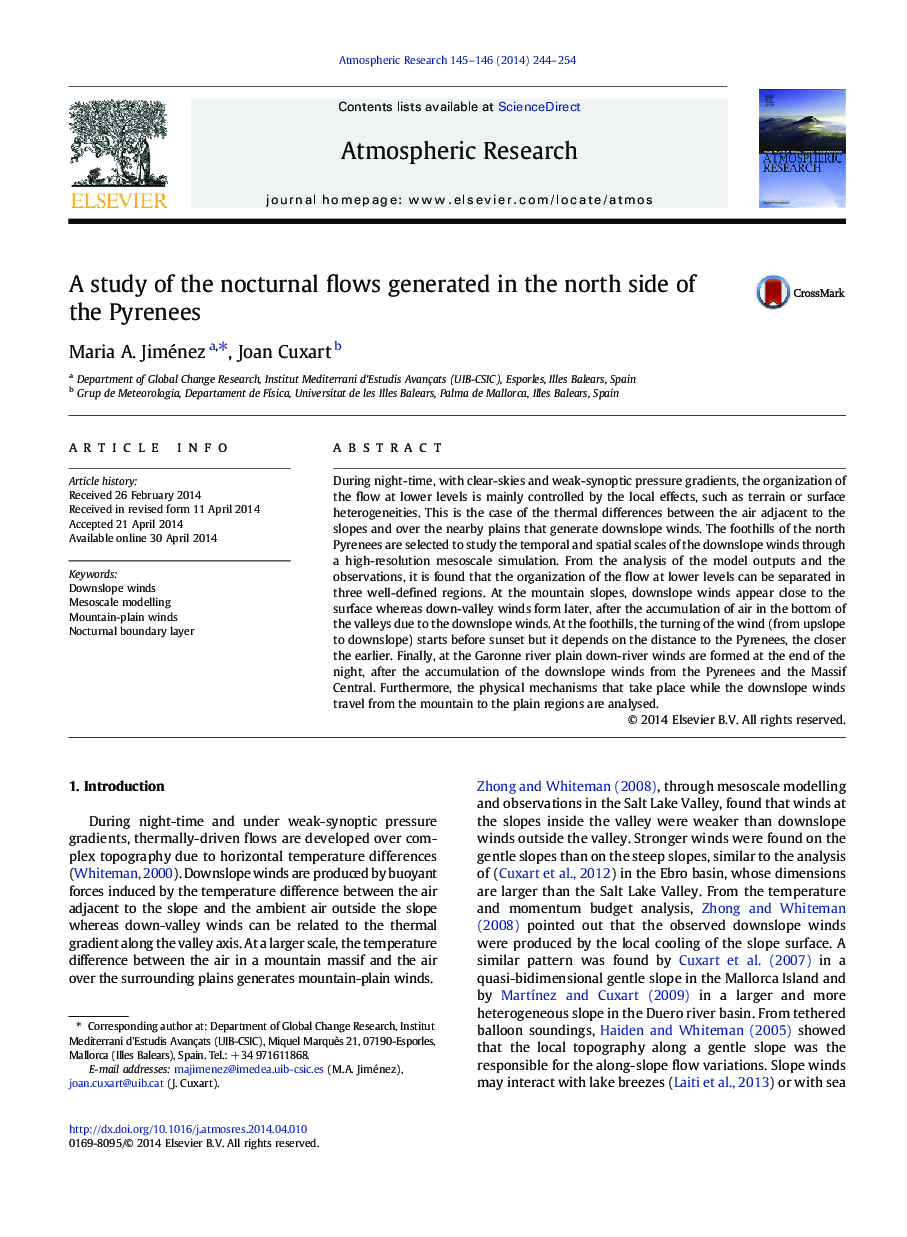| کد مقاله | کد نشریه | سال انتشار | مقاله انگلیسی | نسخه تمام متن |
|---|---|---|---|---|
| 6343577 | 1620526 | 2014 | 11 صفحه PDF | دانلود رایگان |
عنوان انگلیسی مقاله ISI
A study of the nocturnal flows generated in the north side of the Pyrenees
ترجمه فارسی عنوان
مطالعه جریان های شبانه تولید شده در قسمت شمالی پیرنه ها
دانلود مقاله + سفارش ترجمه
دانلود مقاله ISI انگلیسی
رایگان برای ایرانیان
ترجمه چکیده
در طول شب با استفاده از شیب های واضح آسمان و ضریب همبستگی ضعیف، سازمان جریان در سطوح پایین تر عمدتا تحت تأثیرات محلی مانند زمین و یا ناهمگونی های سطحی قرار می گیرد. این مورد تفاوت های حرارتی بین هوا در مجاورت دامنه ها و بیش از دشت های مجاور است که موج های کم عمق را ایجاد می کنند. قرون وسطی پیرنه های شمالی برای مطالعه مقیاس های زمانی و فضایی بادهای بادگیر از طریق یک شبیه سازی مقیاس بزرگ با وضوح بالا انتخاب شده است. از تجزیه و تحلیل خروجی های مدل و مشاهدات، پیدا شده است که سازمان جریان در سطوح پایین تر را می توان در سه منطقه به خوبی تعریف شده است. در دامنههای کوهی، بادهای ضخیم در نزدیکی سطح ظاهر میشوند، در حالی که بعد از انباشت هوا در پایین درهها به علت باد بادهای پایین، شکل میگیرد. در قرون وسطی، چرخش باد (از قله به پایین) شروع می شود قبل از غروب خورشید، اما این بستگی به فاصله تا پیرنه، نزدیک تر از قبل. سرانجام در دشت هارون، در پایان شب، پس از انباشته شدن بادهای ضعیف از پیرنه ها و مرکزی ماسیف، دشت های پایین رودخانه شکل می گیرند. علاوه بر این، مکانیزم های فیزیکی که در حالی که باد با سرعت پایین از کوه به مناطق دشت حرکت می کند، تحلیل می شود.
موضوعات مرتبط
مهندسی و علوم پایه
علوم زمین و سیارات
علم هواشناسی
چکیده انگلیسی
During night-time, with clear-skies and weak-synoptic pressure gradients, the organization of the flow at lower levels is mainly controlled by the local effects, such as terrain or surface heterogeneities. This is the case of the thermal differences between the air adjacent to the slopes and over the nearby plains that generate downslope winds. The foothills of the north Pyrenees are selected to study the temporal and spatial scales of the downslope winds through a high-resolution mesoscale simulation. From the analysis of the model outputs and the observations, it is found that the organization of the flow at lower levels can be separated in three well-defined regions. At the mountain slopes, downslope winds appear close to the surface whereas down-valley winds form later, after the accumulation of air in the bottom of the valleys due to the downslope winds. At the foothills, the turning of the wind (from upslope to downslope) starts before sunset but it depends on the distance to the Pyrenees, the closer the earlier. Finally, at the Garonne river plain down-river winds are formed at the end of the night, after the accumulation of the downslope winds from the Pyrenees and the Massif Central. Furthermore, the physical mechanisms that take place while the downslope winds travel from the mountain to the plain regions are analysed.
ناشر
Database: Elsevier - ScienceDirect (ساینس دایرکت)
Journal: Atmospheric Research - Volumes 145â146, AugustâSeptember 2014, Pages 244-254
Journal: Atmospheric Research - Volumes 145â146, AugustâSeptember 2014, Pages 244-254
نویسندگان
Maria A. Jiménez, Joan Cuxart,
